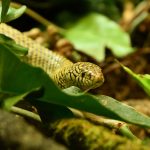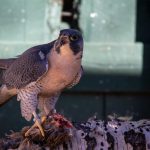
Slithering through the sun-soaked swamps, forests, and fields of the southeastern United States is a snake that lives up to its royal name – the Florida kingsnake. The Florida kingsnake is a subspecies of the common kingsnake. With striking patterns, a calm demeanor, and a reputation as a snake-eating snake, this native Floridian is a true gem of the herpetological world.
These beauties are easily identified by their dazzling scales, which range in colour from brown to yellow, and are adorned with more than 40 yellowish crossbands and a unique chain-like pattern along their sides. No two snakes are exactly alike!
Florida kingsnakes aren’t picky eaters. They’ll dine on rodents, birds, frogs, lizards, eggs, and even other snakes – including venomous ones like rattlesnakes and copperheads! Kingsnakes are immune to the venom of many native pit vipers, and they’re powerful constrictors, using strong coils to subdue their prey before swallowing it whole.
CLICK THROUGH THE TABS BELOW TO LEARN MORE!
Florida kingsnakes typically grow to be 120-150 cm (4-5 ft). The maximum recorded length is 176.5 cm (69.5 in.)
You can find Florida Kingsnakes throughout the Florida peninsula and even down to Key Largo. They can be found in a wide range of habitats: pine flatwoods, hardwood hammocks, cypress swamps, coastal dunes, and even suburban neighborhoods. They’re excellent climbers and strong swimmers, but they tend to spend a lot of time hidden under logs, leaf litter, or debris.
They’re apex predators in their ecosystems and help keep populations of smaller animals – including dangerous snakes – in check. As true opportunivores, they enjoy a broad diet that includes small mammals, birds, amphibians, lizards, turtles, and other snakes. Their preferred snacks in the wild seem to be reptiles and their eggs.
Florida Kingsnakes are non-venomous and generally harmless to people and pets! While they might bite if cornered or bothered, their usual response is to flee. If they do feel threatened, they might vibrate their tails to make a buzzing sound, or release a musky scent – all to encourage people to leave them alone. They’re not aggressive and rarely bite.
After 55-65 days of incubation, females lay between 3 and 30 white eggs (though usually fewer than 12) from June to September. They find cozy spots in rotting logs, rock crevices, or even underground burrows for their offspring. Like many reptiles, the incubation temperature of the snake’s eggs may determine the offspring’s sex! Warmer temperatures usually favour males, while cool temperatures favour females.
10-15 years.
Florida kingsnakes aren’t considered endangered or threatened, but like many native species, they face pressure from habitat loss, road mortality, and invasive species. By preserving natural areas and being mindful of wildlife, we can help ensure this regal reptile continues to thrive.















